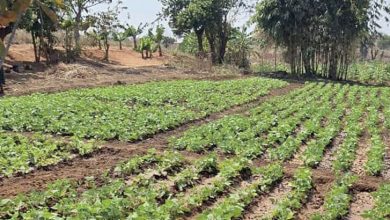Unending woes of relocated cyclone survivors
The Government of Malawi declared Makhanga in Nsanje inhabitable, forcing displaced people in the area to relocate to Osiyana and Militoni. In this last slot, our Staff Writer KONDWANI KAMIYALA continues to look at lives of survivors of Cyclone Freddy who were relocated to Militoni Village. He writes:
Margaret Julius can’t tell you her age. She doesn’t know it. But one can gauge her age at a little over 70. The wrinkles on her face, the strands of gray hair protruding through her headgear, a few missing incisors, and her utse dance moves will tell you one thing: She has seen better days.

In March 2023, having spent two nights on an empty stomach, hanging in a tree with ravaging waters of the Ruo and Shire rivers washing away villages, farmland and livestock in her Chimwmadzi Vilage at Makhanga in Nsanje, Margaret Julius was rescued and joined other survivors at the Bangula Admarc camp.
In September last year, Julius joined other survivors to Militoni Village where senior group village head Kalonga led 23 chiefs and their subjects to the land of resettlement, leaving their ancestral land with assistance from government and other charities. Makhanga was declared inhabitable as it was submerged annually when the Shire and its biggest tributary, Ruo, flooded.
According to statistics from the Department of Disaster Management Affairs (DoDMA), when Tropical Cyclone Freddy hit, 13 people died in Nsanje, while 15 were missing and 12 were injured. It records that 29 174 households were displaced, leaving 131 283 people destitute.
The migration to Militoni was a sigh of relief for Julius and other villagers who swear they would never return to Makhanga.
But today, the elderly woman still lives in the temporary shelter, a three-by-five-metre structure with dust floor, black plastic sheeting and grass thatched roof. She missed out when a charity, GiveDirectly, made unconditional cash transfers of K1 280 000 to 966 households who constructed new homes, bought food and livestock, and started business.
“This is my home. I can’t go back to Makhanga. I have seen worse days when the two rivers flooded every year. I thank God who gave our chief the wisdom to lead us up here from Makhanga. But I wish I had a better house to dwell in. Look, I am too old and I have nothing,” she said.
Apart from housing, relocated villagers interviewed complained bitterly about hunger.
Kalonga recalled how 15 villagers nearly died after eating yams, locally known as mipama. If not properly cooked, the yams are poisonous.
“The villagers had upset stomachs, they were feeling dizzy. We pound charcoal which I forced them to take as first aid before taking them to Katchika and Phokera health facilities where they were treated,” said Kalonga.
To get to Phokera, the chief had to cough K4 000 for each of the survivors of that ordeal, while those that went to Katchika used K7 000 on a kabaza. Nsanje Lalanje parliamentarian Gladys Ganda offered transport for their way back to the village.
It is this long distance to the nearest heath facility that worries 62-year-old Sophia Petulo. Every month, she has to go to Phokera to get medication, but she cannot afford the return fare.
“I have to go to the hospital once every month to get medication for high blood pressure. But I skip most of the times because I don’t have the money for kabaza. A few days ago, someone in a nearby village died because there was no means of transport to get her to the hospital,” she said.
Democratic Progressive Party (DPP) Nsanje Mlonda Ward councillor Cassim Ussen Ngwali agrees the relocated villagers face a host of problems, including lack of shelter, unsafe water, long distances to health facilities and schools. Ngwali, who is Nsanje district council chairperson, said they are still working to make life better for the relocated villagers.
“Most of them are hit by hunger. There has been no relief food here. Last month, we only got 20 bags, which was insufficient. We hope government and other well-wishers will come and assist. We can’t solve all problems in one day,” he said.
According to him, 20 percent of the 2 700 survivors in Nsanje, like Julius still live in temporary shelters since government decomissioned about 62 eviction camps set up in schools, churches, mosques and other structures nationwide for Cyclone Freddy survivors.
“We thank well-wishers like GiveDirect. As a district, we had more people who relocated to Osiyana from Makhanga.Some of those at Militoni are still in dire need,” he said.
Ngwali said the settlers also lack safe water as the five boreholes that were sank in the government allocated land dried up with the scorching Nsanje heat. Schools, like Mpatsa were washed away, he said, forcing children to walk longer distances for education.
“The plan is to erect solar pumps so that the boreholes can get water from deeper levels. While there is a junior primary school close to the village, learners have to cross some rivers to get to the nearest school and we need a bridge with the rainy season fast approaching,” he said.
Concurring with Ngwali, a villager, Idesi William says to get to Chibakhwe Primary School, learners have to cross two rivers.
“At Makhanga, our children had several schools to choose from like Chigwamafumu, Chikale and Makhanga. But here, our children have to walk for an hour or so to the nearest school,” she said.
According to DoDMA, 7 000 households were relocated in Nsanje. DoDMA public relations officer Chipiliro Khamula said the department prioritizes the most marginalized and vulnerable communities, including the elderly, people with disabilities, people with chronic illnesses and child-headed families.
“The department appreciates the challenges people relocating to safer places face, especially on shelter. The provision of support is the result of tireless efforts by the department and continued engagement with partners like Give Directly. With continued engagement, we are optimistic of having decent and durable shelter for relocating communities,” he said.
According to him, the department is not only ‘relocating’ communities but also amenities like schools, citing the Makhanga Community Day Secondary School which relocated to the newly-constructed evacuation centre in Osiyana as an example.
“We also sourced funds from the Government of South Korea and we are currently constructing the new Makhanga Primary School. The Presidential Initiative also provided funds for the construction of the new Mpatsa Primary School, signifying how committed the department is for the cause,” said Khamula.
He observes that in the case of emergencies councils need to conduct assessments and identify beneficiries in case of the lean season.
Speaking recently at the Nsanje Prison ground, Minister of Local Government Richard Chimwendo Banda announced that the government would reach out to 40 000 households in the district with relief items.
So, the relocated villagers at Militoni will bring you a host of woes they face. Julius will tell you of no shelter. Fanita Bulasha will tell you about lack of food. Pensulo will cry for health care. Kalonga looks for a day her subjects will cultivate as much as they did at Makhanga. But, you haven’t heard from 82-year-old Alepha Antonio. She only has a ‘chitenje’ to cover herself up. She has no clothing.





